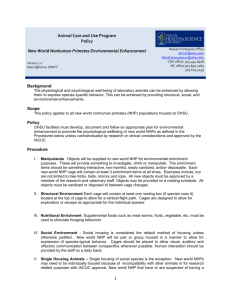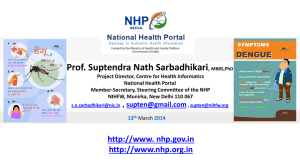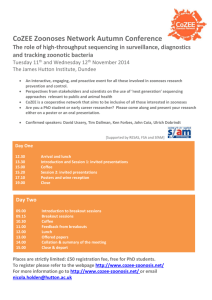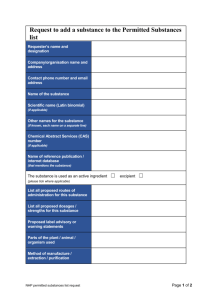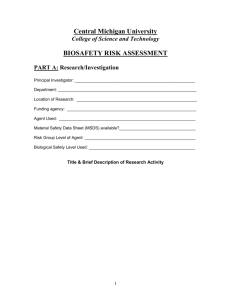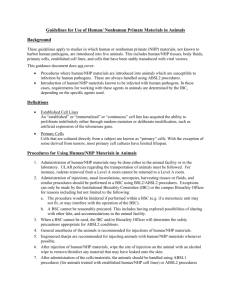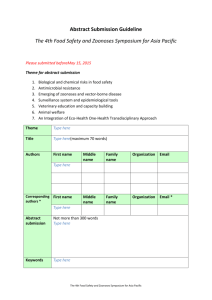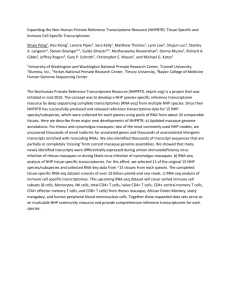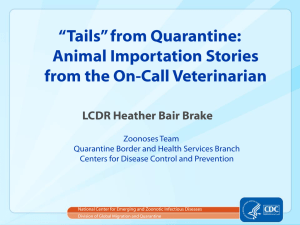Zoonoses of Nonhuman Primates
advertisement
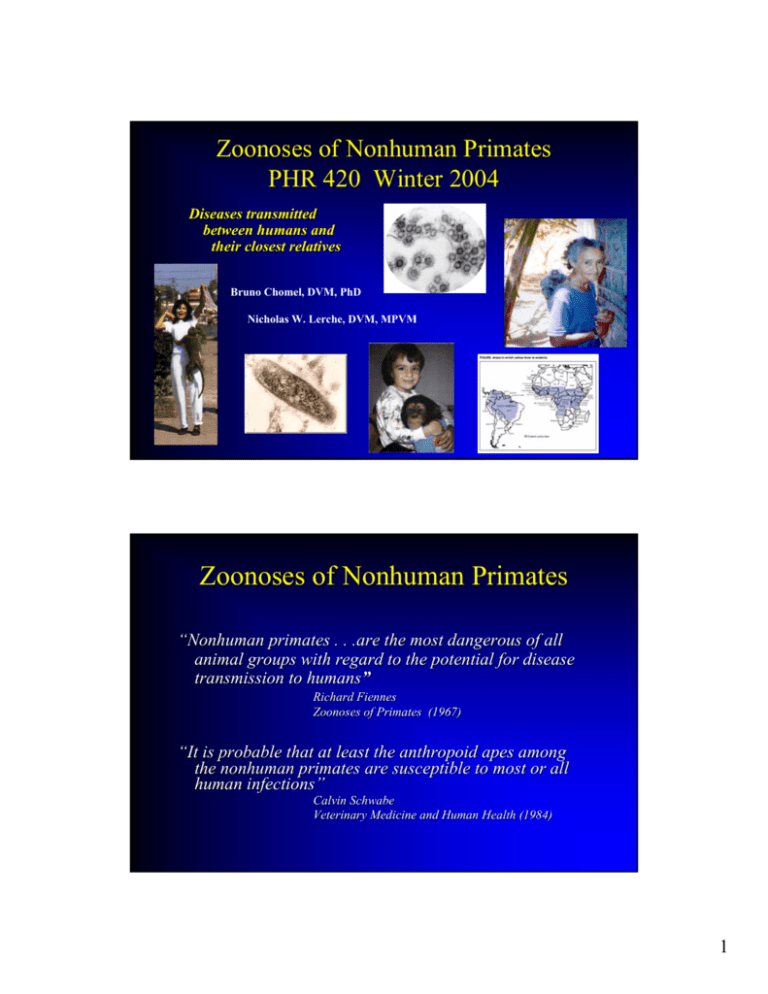
Zoonoses of Nonhuman Primates PHR 420 Winter 2004 Diseases transmitted between humans and their closest relatives Bruno Chomel, DVM, PhD Nicholas W. Lerche, DVM, MPVM Zoonoses of Nonhuman Primates “Nonhuman primates . . .are the most dangerous of all animal groups with regard to the potential for disease transmission to humans” Richard Fiennes Zoonoses of Primates (1967) “It is probable that at least the anthropoid apes among the nonhuman primates are susceptible to most or all human infections” Calvin Schwabe Veterinary Medicine and Human Health (1984) 1 Zoonoses of Nonhuman Primates Contemporary Public Health Issues Primate Zoonoses? AIDS? Hepatitis? Cancer? Unknown agents? Zoonoses of Nonhuman Primates Some General Categories “Shared pathogens” – pathogens equally infectious to both human and NHP acquired from environmental source of from non-primate reservoir species (e.g. Monkey pox, Shistosomiasis) Pathogens for which humans are natural or reservoir hosts; NHP are aberrant host species (e.g. Measles virus, Tuberculosis) Pathogens for which NHP are the natural hosts; humans the aberrant host (e.g. Yellow fever, B virus) 2 Human/NHP Interactions Opportunities for Cross-species Transmission “Ecological” Humans and NHP share the same ecosystem “Occupational” Humans working with NHP is zoos or research facilities “Recreational” NHP kept as pets; Ecotourism “Medical” Xenotransplantation; Vaccines or biologics produced in NHP cell culture Ways of Thinking about Primate Zoonoses Zoonoses resulting from direct human/NHP contact (e.g. B virus encephalomyelitis) Zoonoses resulting from transfer of NHP disease from remote habitat to high density human populations (e.g. Urban yellow fever) “Species Jumping” – initial transmission from NHP to human population, with subsequent human to human transmission (e.g. HIV/AIDS) 3 Zoonoses of Nonhuman Primates Some Terminology “Zoonosis” – disease transmissible between animals and humans “Isozoonosis” – a disease showing similar clinical signs and pathology in human and animal hosts “Remote zoonosis” – strictly human disease resulting from an ancient cross-species transmission event Zoonoses Classification (Direction of Transmission) “Anthropozoonosis” – disease transmitted from animals to humans “Zooanthroponosis” – disease transmitted from humans to animals “Amphizoonosis” – transmission can occur in either direction 4 WHO Classification of Zoonoses (Maintenance Cycle in Nature) “Direct zoonosis” – maintenance in single vertebrate species “Cyclozoonosis” – maintenance requires more than one vertebrate species “Metazoonosis” – cycle requires both vertebrate and invertebrate species “Saprozoonosis” – cycle requires inanimate reservoirs or development sites as well as vertebrate species Recently Recognized Infectious Agents of NHP: Potential Zoonoses Viruses Simian TT-lymphotropic virus Simian Immunodeficiency virus Ebola Reston Baboon polyomavirus type 2 Ebola Cote d’Ivoire Simian Parvovirus Baboon reovirus Simian rhadinovirus (HHV8(HHV8-like) Simian Hepatitis G virus Callitrichid lymphocryptovirus Marmoset rabies virus ` 1982 1984 1989 1989 1994 1994 1994 1997 1998 2001 2001 5 Recently Recognized Infectious Agents of NHP: Potential Zoonoses Bacteria Helicobacter pylori Ehrlichia chaffeensis Protozoa Cyclospora spp. 1994 2002 1996 Human Infectious Diseases with NHP Origins: “Remote Zoonoses” Malaria (e.g. Plasmodium vivax) HIV/AIDS Hepatitis B Dengue fever HTLV/T-cell leukemia/lymphoma 6 Ways of Thinking about Primate Zoonoses Humans and NHP – “Parallel Universes” Many (most?) “human pathogens” have genetically and antigenically closely related counter-parts in one or more species of NHP Introduction (continued) 7 Geographic Distribution of NHP From: R. Fiennes, Zoonoses of Primates; 1967 Taxonomy of Nonhuman Primates A Very Brief Introduction Order Primates 1111-13 Families 66 Genera Approx. 280 Species Vary in size by several orders of magnitude from mouse lemurs weighing 30 grams to mountain gorillas weighing up to 200 kilograms 8 Taxonomy of Nonhuman Primates A Very Brief Introduction Prosimians (Suborder Prosimii) Means “before apes” or “before monkeys” Occur only in Old World Tropics Tapetum lucidum (night vision) Moist rhinarium (enhances smell) Large and mobile ears Taxonomy of NHP Prosimians (cont.) Muzzle and brows with whiskers Eyes face slightly lateral 36 teeth with “toothcomb” Flat nails all digits except 2nd digit of foot (“toilet claw”) Specialized scent glands Toothcomb 9 Prosimians Bush Baby (Galago) Slender Loris Ringtailed Lemur Mouse Lemur Taxonomy of NHP Tarsoidea Tarsiers Share characteristics of both prosimians and anthropoids Large eyes, mobile ears Lack naked rhinarium and dental comb Tarsius spp. spp. 34 teeth Arboreal Large hands/feet for clinging Diet of insects, small vertebrates 10 Anthropoidea Monkeys and Apes Short faces, dry noses, lack of prominent whiskers Ears are small and virtually immobile Eyes-face forward (adapted for diurnal vision) Stereoscopic color vision (no tapetum) Lack grooming claws, toothcomb Dental formula varies from 32-36 Flat nails on all digits Anthropoidea New World Monkeys New World Monkeys (Platyrrhines) Broad flat noses, nostrils wide apart and face laterally Prehensile tail present in some species (not all) Platyrrhine nose 2 Families of NW Monkeys Callitrichidae – marmosets and tamarins Cebidae – capuchins, squirrel monkeys, owl monkeys, howler monkeys, spider monkeys Prehensile tail 11 New World Monkeys Squirrel monkey Owl monkey Common marmoset Capuchin Golden Lion tamarin Spider monkey Howler monkey Anthropoidea Old World Monkeys Old World Monkeys (Catarrhines (Catarrhines)) Distinct from platyrrhines by dentition Narrow nose, nostrils face down Ischial callosities present (some species) Cheek pouches present (some species) Family Cercopithecidae Subfamily: Cercopithecinae Macaques, Mangabeys, Mangabeys, Baboons, Guenons, Talapoins, Talapoins, Patas Subfamily: Colobinae Colobus, Colobus, Langurs Catarrhine Nose 12 Old World Monkeys Long-tailed macacque Colobus Patas monkey African Green monkey Talapoin Olive Baboon Red-capped mangabey Family Pongidae Anthropoidea Apes Family Hylobatidae Gibbons and Siamangs Chimpanzee Gorilla Orangutan 13 Major Differences Between Old and New World Primates Direction of nares Nasal septum Ischial callosities Cheek pouches Colonic sigmoid flexure Sex skin Premolars/molars Prehensile tail NW OW lateral broad absent absent absent absent 3/2 +/- down narrow present +/present present 2/3 - Evolutionary Relationships of Modern NHP 14 Major Health Problems of Nonhuman Primates in Captivity Infectious disease accounts for roughly two-thirds of disease problems in captive primates G.I. disease accounts for the largest proportion of morbidity Major Health Problems of NHP Gastrointestinal Disease Common Pathogens and Parasites Campylobacter spp. Shigella spp. Cryptosporidium parvum Giardia lamblia Yersinia enterocolitica Entamoeba histolytica Balantidium coli Trichuris spp. 15 Major Health Problems of NHP Gastrointestinal Disease Less Common Pathogens and Parasites Salmonella spp. Strongyloides spp. Enteropathogenic Escherichia coli Rotavirus Major Health Problems in NHP GI Disease – Magnitude of the Problem Survey of 18 Primate Facilities > 13,000 NHP of various species Diarrheal disease Overall Incidence = 10.6% (range 2.1-18.8%) Diarrhea-specific mortality = 1.2% Diarrhea Case-fatality rate = 11.1% Incidence and mortality highest in infants Adapted from Hird et al. Lab. Anim. Anim. Sci. Sci. 34:46534:465-470; 1984 16 Major Health Problems of NHP Respiratory Disease Agents of Bacterial Pneumonia Streptococcus pneumoniae Staphylococcus aureus Hemophilus influenzae Klebsiella pneumoniae Bordetella bronchisepticum Mycobacterium tuberculosis Respiratory Viruses Parainfluenza type 3 Respiratory syncytial virus *Respiratory virus infections underdiagnosed Cross-species Transmission Among NHP Increased Virulence in Unnatural Host Simian Hemorrhagic Fever Virus African NHP Asian macaques Herpesvirus saimiri Squirrel monkey Other NW monkeys Simian Immunodeficiency Virus African NHP Asian macaques B Virus Asian macaques Other OW and NW NHP 17
